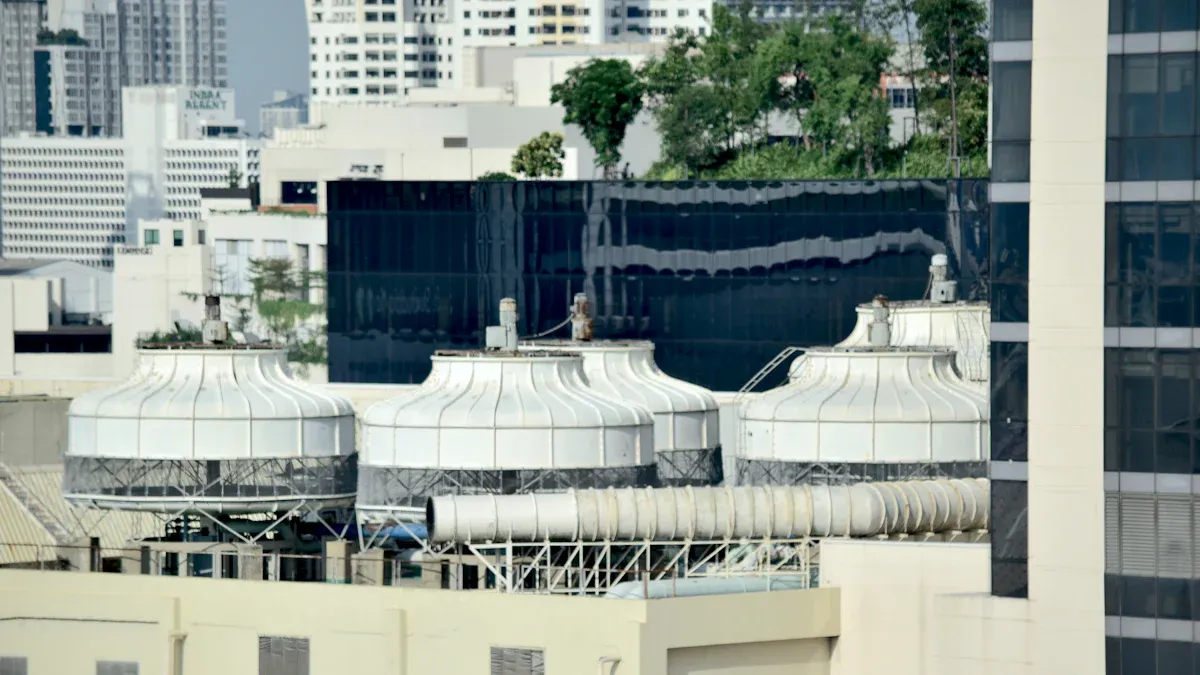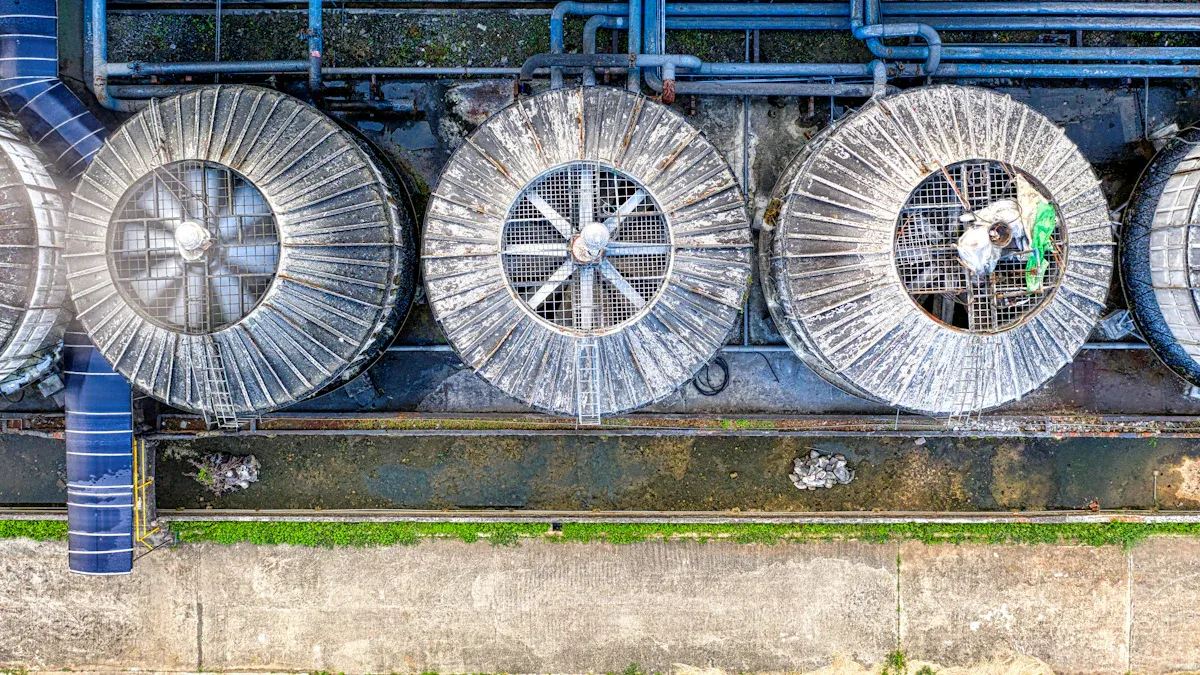How to Keep Your Water Chiller Running Smoothly

Keeping your water chiller working well needs regular care. Routine maintenance makes it work better and use less energy. Clean condenser coils help transfer heat and save power. Checking refrigerant levels often stops losing up to 10% efficiency. Skipping maintenance can raise energy bills by 20–25% due to more power use. Good water quality stops dirt build-up and keeps it running smoothly. Regular servicing helps your chiller last longer, often over 15 years with proper care.
Key Takeaways
Regular care helps your water chiller work well and saves energy by up to 30%.
Check water levels often to stop overheating and keep it running smoothly.
Clean filters and coils every month to improve airflow and cooling.
Look for leaks or damage each week to fix problems early and save money.
Get a professional check-up two times a year to find hidden issues and keep it efficient.
Daily and Weekly Maintenance for Your Water Chiller
Checking and Maintaining Water Levels
Keeping the right water level helps your chiller work well. Check the water level often to make sure it’s correct. If the water is too low, the system can overheat and cool less.
Here are simple ways to save water and improve efficiency:
Use tools to measure conductivity and control blowdown levels.
Treat water with chemicals to stop scale and improve cycles.
Automate chemical dosing based on real-time system needs.
Filter water to remove dirt and keep it clean.
Use other water sources, like condensate, for cooling tower makeup.
These steps help save water, make the system work better, and last longer.
Monitoring Temperature and Performance
Keeping the right temperature is key for your chiller’s performance. Check the system’s temperature daily to keep it in the safe range. Stable temperatures stop problems and keep cooling steady.
For example, Ford Motor Company used a 1,000-ton system at 70°F±1°F for painting. This saved $800,000 yearly by reducing paint mistakes. Your system may not need this level of control, but steady temperatures help avoid repairs and improve efficiency.
Use gauges and tools to watch for temperature changes. Fix any issues quickly to stop further damage.
Inspecting for Leaks or Visible Damage
Leaks and damage can hurt your chiller’s performance. Look at the system weekly for cracks, leaks, or worn parts. Check hoses, pipes, and connections since they often get damaged.
Fix leaks right away to stop water loss and poor performance. Rust or corrosion might mean bigger problems that need expert help. Regular checks catch issues early and save repair costs.
Tip: Use a flashlight during checks to find hidden leaks or damage in tight spots.
Monthly and Seasonal Maintenance Tasks
Cleaning Filters and Condenser Coils
Filters and condenser coils are key to your chiller’s performance. Over time, dirt and debris can collect on them. This buildup makes it harder for the system to transfer heat. Cleaning them often helps your chiller work better.
Dirty filters block airflow, making the system use more energy.
Debris on condenser coils reduces heat transfer and causes overheating.
Regular cleaning avoids these problems and keeps the system efficient.
To clean filters, take them out and wash off dirt. For condenser coils, use a soft brush or cleaner to remove buildup. Always follow the manufacturer’s instructions to prevent damage.
Tip: Clean filters and coils at least once a month for best results.
Inspecting Electrical Components and Connections
Electrical parts are crucial for your chiller to work safely. Loose wires or worn parts can cause failures or safety risks. Checking these parts regularly helps find problems early.
Look for loose wires or rusted terminals.
Check for overheating signs like burnt smells or discoloration.
Test electrical controls to ensure they work properly.
If you see any issues, call a professional to fix them. Regular checks lower the chance of breakdowns and help your chiller last longer.
Flushing the System to Remove Build-Up
Flushing clears out mineral deposits, sediment, and other buildup. Even a thin layer of scale can raise energy use by 15%. This buildup lowers efficiency and can grow harmful bacteria.
Mineral deposits can block pipes and slow water flow.
Sediment can cause rust and damage inside the system.
The CDC says flushing helps prevent health risks like Legionnaires’ disease.
To flush, drain the water, clean the parts, and refill with treated water. Do this seasonally or as the manufacturer suggests.
Note: Flushing improves efficiency and makes the system safer and healthier.
Troubleshooting Common Water Chiller Issues

Finding and Fixing Strange Noises
Strange noises in your water chiller mean something might be wrong. These sounds could be rattling, buzzing, or squealing. Finding where the noise comes from helps fix the problem early.
Here’s how to handle common noises:
Rattling Sounds: Loose screws or panels often cause rattling. Check the outside of your chiller and tighten anything loose.
Buzzing Noises: Buzzing might mean electrical problems. Look at the wires and connections for damage or wear.
Squealing or Whining: This could mean a bad fan belt or motor parts. Replace these if needed.
Tip: Always turn off the power before checking or fixing your chiller. This keeps you safe while working.
If the noise doesn’t stop after these steps, call a professional. Ignoring strange sounds can cause bigger problems later.
Fixing Temperature Changes
Temperature changes in your chiller can hurt its performance. These changes might happen because of thermostat issues, blocked airflow, or refrigerant troubles.
Try these steps to fix the temperature:
Check the Thermostat: Make sure the thermostat is set correctly. Adjust it if it’s wrong.
Look at Airflow: Blocked vents or dirty filters can stop airflow. Clean or change filters to fix this.
Check Refrigerant Levels: Low refrigerant makes cooling worse. If there’s a leak, get a professional to refill it.
Note: Keeping the temperature steady helps your chiller work better and last longer.
Watching the system and fixing problems quickly keeps cooling consistent.
Improving Cooling Efficiency
Poor cooling makes your chiller less effective and costs more energy. This often happens from dirt, leaks, or old equipment.
Here’s how to boost cooling efficiency:
Clean the System: Dirt on coils or evaporators blocks heat transfer. Clean these parts often to improve performance.
Look for Leaks: Water or refrigerant leaks lower efficiency. Check for leaks and fix them quickly.
Upgrade Insulation: Bad insulation on pipes or tanks wastes energy. Replace old insulation to save energy.
Callout: If your chiller is old and still inefficient, think about getting a new one. New models use less energy and work better.
Fixing these issues can make your chiller work well again and cut costs.
Best Practices for Long-Term Water Chiller Care
Scheduling Regular Professional Servicing
Getting professionals to check your chiller keeps it working well. They can find hidden problems that regular checks might miss. Plan for expert servicing at least twice a year. This helps catch issues early and avoids expensive repairs.
During these visits, technicians clean inside parts, test performance, and check for damage. They also make sure all parts match the manufacturer’s standards. Regular servicing boosts efficiency and helps your chiller last longer.
Tip: Write down service dates and repairs in a log. This helps you plan future maintenance easily.
Maintaining Proper Refrigerant Levels
Refrigerant is key to your chiller’s cooling process. Low levels can hurt cooling and stress the system. Check refrigerant often to keep it within the right range.
If cooling gets worse or frost forms on coils, there might be a leak. Call an expert to fix leaks and refill refrigerant. Using the correct type and amount is very important for good performance.
Note: Too much refrigerant can harm the system. Always follow the manufacturer’s rules.
Ensuring Energy Efficiency and Proper Storage
Saving energy lowers costs and helps the environment. Clean filters and condenser coils often to improve efficiency. Wrap pipes with insulation to stop energy loss and keep cooling steady.
When not using your chiller, drain it completely to avoid freezing or rust. Cover it to keep out dust and dirt. Storing it properly keeps it ready for future use.
Callout: Saving energy not only cuts costs but also helps the planet.
Taking care of your water chiller helps it work well. Easy jobs like cleaning filters and checking refrigerant levels save energy. These tasks also lower repair costs. Good maintenance can cut energy use by 30% or more. It helps your chiller last longer and stay reliable. Fixing problems like leaks or strange noises early avoids expensive repairs. Regular care, such as testing and treating water, improves performance. It often saves money within months by lowering energy bills.
Tip: Keeping your water chiller in good shape saves money and ensures it works when needed.
FAQ
What is the best temperature for a water chiller?
The best temperature depends on your system. Most chillers work well between 45°F and 70°F. Check your manufacturer’s guide for the exact range. Keeping the temperature steady helps it work better and last longer.
How often should filters be cleaned?
Clean filters at least once every month. If your chiller is in a dusty area, clean them more often. Dirty filters block airflow, making the system less efficient and use more energy.
Can untreated water be used in a chiller?
Do not use untreated water. It can cause scale, rust, and bacteria to grow. Always treat the water with the right chemicals to keep the system working well and avoid damage.
What should I do if my chiller has a leak?
Check where the leak is coming from right away. Tighten loose parts or replace broken ones. If the leak doesn’t stop, call a professional. Ignoring leaks can waste water and hurt cooling performance.
How can I make my chiller use less energy?
Clean condenser coils, check refrigerant levels, and insulate pipes. Regular maintenance and professional checks also help. Upgrading to newer, energy-saving models can lower energy costs even more.
Tip: Write down cleaning, checks, and repairs in a log. This keeps you organized and helps with timely maintenance.
See Also
A Comprehensive Guide To Water Chiller Unit Functionality
Proven Strategies To Enhance Walk-In Chiller Efficiency
Maximizing Performance Of Chillers And Compressors In ARKREF Units
Choosing The Right Industrial Water Chiller Units Made Easy
Essential Maintenance Tips For Your Plate Freezer Efficiency

